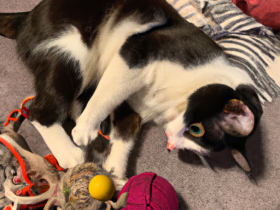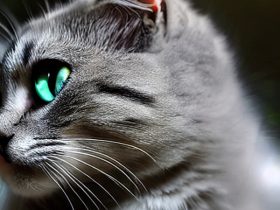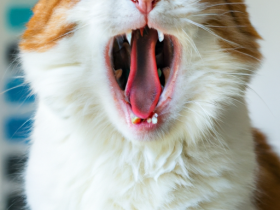“Unlock the Keys to a Healthy Feline Life with Understanding Feline Diabetes and How to Manage It!”
Introduction
Feline diabetes is a serious condition that can affect cats of all ages, breeds, and sizes. It is caused by a lack of insulin production or an inability of the body to use insulin properly. If left untreated, feline diabetes can lead to serious health complications, including blindness, kidney failure, and even death. Fortunately, with proper management, cats with diabetes can live long and healthy lives. In this article, we will discuss the causes, symptoms, and treatments of feline diabetes, as well as how to manage it. We will also provide tips on how to prevent diabetes in cats.
What is Feline Diabetes and What Are the Symptoms?
Feline diabetes is a condition in which cats have abnormally high levels of glucose (sugar) in their blood. It is caused by a lack of insulin, a hormone produced by the pancreas that helps regulate blood sugar levels.
The most common symptoms of feline diabetes include increased thirst and urination, weight loss, and lethargy. Cats may also experience a decrease in appetite, vomiting, and changes in their coat and skin. If left untreated, feline diabetes can lead to serious complications such as kidney failure, blindness, and even death.
Diagnosis of feline diabetes is typically done through a combination of physical examination, blood tests, and urine tests. Treatment typically involves a combination of diet, exercise, and insulin injections. It is important to monitor your cat’s blood sugar levels regularly to ensure that the diabetes is being managed properly.
If you suspect that your cat may have diabetes, it is important to seek veterinary care as soon as possible. Early diagnosis and treatment can help prevent serious complications and ensure that your cat lives a long and healthy life.
How to Monitor Your Cat’s Blood Glucose Levels
Monitoring your cat’s blood glucose levels is an important part of managing their diabetes. It is important to understand the basics of how to monitor your cat’s blood glucose levels in order to ensure that your cat is receiving the best care possible.
The first step in monitoring your cat’s blood glucose levels is to purchase a glucometer. This device measures the amount of glucose in the blood. It is important to purchase a glucometer that is specifically designed for cats, as the readings may be different than those for humans.
Once you have the glucometer, you will need to purchase test strips. These strips are used to collect a sample of your cat’s blood. It is important to use the correct type of test strip for your glucometer.
Once you have the glucometer and test strips, you will need to collect a sample of your cat’s blood. This can be done by pricking your cat’s ear with a lancet. It is important to be gentle when doing this, as it can be painful for your cat.
Once you have collected the sample, you will need to place it on the test strip and insert it into the glucometer. The glucometer will then give you a reading of your cat’s blood glucose levels. It is important to record this reading in a log so that you can track your cat’s progress over time.
Monitoring your cat’s blood glucose levels is an important part of managing their diabetes. By following these steps, you can ensure that your cat is receiving the best care possible.
Diet and Exercise Tips for Managing Feline Diabetes
Feline diabetes is a serious condition that requires careful management to ensure your cat’s health and wellbeing. With the right diet and exercise plan, you can help your cat manage their diabetes and live a long and healthy life.
Diet:
• Feed your cat a high-fiber, low-carbohydrate diet. This will help to regulate your cat’s blood sugar levels and reduce the risk of complications.
• Avoid feeding your cat treats or table scraps, as these can cause spikes in blood sugar levels.
• Feed your cat multiple small meals throughout the day, rather than one large meal. This will help to keep your cat’s blood sugar levels more consistent.
• Monitor your cat’s food intake and weight closely. If your cat is gaining or losing weight, adjust their diet accordingly.
Exercise:
• Encourage your cat to be active by providing toys and activities that will keep them moving.
• Take your cat for regular walks, if possible. This will help to keep them fit and active.
• Make sure your cat has plenty of space to move around and explore.
• If your cat is overweight, talk to your vet about an appropriate exercise plan.
By following these tips, you can help your cat manage their diabetes and live a long and healthy life. If you have any questions or concerns, be sure to talk to your vet.
Understanding the Role of Insulin in Feline Diabetes
Insulin is a hormone produced by the pancreas that helps regulate the body’s blood sugar levels. In cats with diabetes, the pancreas does not produce enough insulin, or the body does not respond to the insulin that is produced. This results in high levels of glucose in the blood, which can lead to serious health complications.
In order to manage diabetes in cats, insulin therapy is often necessary. Insulin therapy helps to reduce the amount of glucose in the blood, allowing the body to use it more efficiently. This helps to reduce the risk of complications associated with diabetes, such as kidney failure, blindness, and nerve damage.
Insulin therapy is typically administered via an injection, either subcutaneously or intramuscularly. The type of insulin used and the dosage will depend on the individual cat’s needs. It is important to work with a veterinarian to determine the best type and dosage of insulin for your cat.
In addition to insulin therapy, it is important to make sure your cat is eating a balanced diet and getting regular exercise. This will help to keep blood sugar levels in check and reduce the risk of complications.
Insulin therapy is an important part of managing diabetes in cats. It helps to reduce the amount of glucose in the blood, allowing the body to use it more efficiently. With proper management, cats with diabetes can lead long and healthy lives.
Exploring the Benefits of Natural Remedies for Feline Diabetes
Feline diabetes is a serious medical condition that can have a significant impact on the health and wellbeing of cats. Fortunately, there are a number of natural remedies that can help to manage the symptoms of this condition and improve the quality of life for cats suffering from diabetes. In this article, we will explore the potential benefits of natural remedies for feline diabetes.
One of the most important benefits of natural remedies for feline diabetes is that they can help to reduce the amount of insulin that cats need to take. Insulin is a necessary medication for cats with diabetes, but it can be difficult to manage and can cause side effects such as weight gain and low blood sugar. Natural remedies can help to reduce the amount of insulin that cats need to take, which can help to reduce the risk of side effects.
Natural remedies can also help to improve the overall health of cats with diabetes. Many natural remedies contain vitamins, minerals, and other nutrients that can help to support the health of cats with diabetes. These nutrients can help to improve the functioning of the pancreas, which is responsible for producing insulin. They can also help to improve the overall health of cats with diabetes by providing them with essential vitamins and minerals that they may not be getting from their diet.
Finally, natural remedies can help to reduce the stress that cats with diabetes experience. Stress can have a negative impact on the health of cats with diabetes, as it can cause them to produce more insulin than they need. Natural remedies can help to reduce stress levels, which can help to improve the overall health of cats with diabetes.
In conclusion, natural remedies can provide a number of benefits for cats with diabetes. They can help to reduce the amount of insulin that cats need to take, improve their overall health, and reduce stress levels. If you have a cat with diabetes, it is worth considering natural remedies as a way to manage the condition and improve the quality of life for your pet.
Q&A
Q1: What is feline diabetes?
A1: Feline diabetes is a condition in which cats have difficulty regulating their blood sugar levels. It is caused by a lack of insulin production or an inability to use insulin properly.
Q2: What are the symptoms of feline diabetes?
A2: Symptoms of feline diabetes include increased thirst and urination, weight loss, lethargy, and poor coat condition.
Q3: How is feline diabetes diagnosed?
A3: Feline diabetes is typically diagnosed through a combination of physical examination, blood tests, and urine tests.
Q4: How is feline diabetes treated?
A4: Treatment for feline diabetes typically involves a combination of diet, exercise, and insulin injections.
Q5: What can I do to help manage my cat’s diabetes?
A5: To help manage your cat’s diabetes, you should feed them a balanced diet, provide regular exercise, and monitor their blood sugar levels. Additionally, you should give them their insulin injections as prescribed by your veterinarian.
Conclusion
In conclusion, understanding feline diabetes and how to manage it is essential for any cat owner. With the right diet, exercise, and medication, cats with diabetes can live long and healthy lives. It is important to monitor your cat’s blood sugar levels regularly and to consult with your veterinarian if any changes occur. With proper management, cats with diabetes can live a long and happy life.








Leave a Reply
View Comments